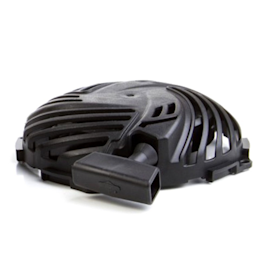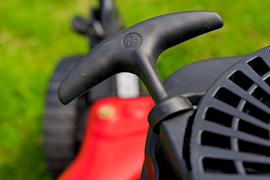Types of walk-behind mower blades video


From standard to specialty blades, there are a lot of options when it comes to walk-behind mower blades. In this video, we’ll explain what each blade does best and when you should use it. We’ll also give you three maintenance tips to keep your blades and mower deck in optimal operating condition.
For additional repair help, including common symptoms and troubleshooting tips, step-by-step lawn mower repair guides and articles, check out our repair help section. In addition, find the lawn mower parts you need to fix your mower.
Hi, Wayne here from Sears PartsDirect. Today we're going to talk about different types of blades used on walk-behind lawn mowers.
Standard-issue blades
Your mower probably came with one of these common types of blades when you bought it.
Your owner's manual may list optional blades available for your mower. Not all of the blades that we cover in this video are compatible with your mower so check your manual regarding blade use to avoid problems.
Standard blade
This standard blade has straight sides and a slight upward curve along the back edge. The curve helps blow the clippings out through the side discharge chute or through a rear chute into a collection bag.
High-lift or 2-in-1 blade
Some mowers need a high-lift blade to help push grass clippings up through a side-discharge bagger chute.
The curved tips of a high-lift blade blow grass clippings up and then out through the side discharge chute.
Some manufacturers call this blade a 2-in-1 blade by because it gives you the option to either discharge clippings out the side chute or into the bag when it’s attached.
Mulching blade
The mulching blade looks a bit different. Its contoured shape and raised blade tips swirl the grass clippings around inside the deck. The blade’s long cutting edges repeatedly chop the grass clippings into smaller pieces that break down faster.
Mulching blades work best when you cover the side discharge and collection bag holes so clippings get more thoroughly chopped before falling down onto the lawn.
On some mowers with a rear bag chute, you can also use a collection bag with the mulching blade installed.
3-in-1 blade
Some mowers use a standard-issue 3-in-1 blade that gives you the option to side discharge, bag or mulch grass clippings.
The curved blade tips provide lift for discharge and bagging, while the contoured shape and long cutting edges shred grass into mulch.
Ninja blade
Snapper Ninja mowers use this unique style of blade that has 6 cutting surfaces designed to finely cut grass clippings into mulch. Ninja blades also help lift grass clippings when bagging.
Although this blade looks cool, you can't use it on every mower. It's designed for use only on compatible Snapper Ninja mowers.
Specialty blades
If you want a blade that is a cut above what came with your mower or has a unique function, one of these blades might be just what you’re looking for.
Check your owner's manual for blade use guidelines before choosing a specialty blade to make sure it works on your mower. Not all specialty blades work on every machine.
Slotted blade
Some after-market manufacturers offer specialty 3-in-1 and mulching blades with slots on the side that face up, away from the ground. The slots help control air flow under the mower so grass clipping are recut more often—making finer mulch.
Dethatching blade
A dethatching blade uses spring-loaded prongs or nylon strands to rake and dethatch your lawn. Only use a dethatching blade to remove thatch or to prepare your lawn for overseeding. It’s definitely not for regular use.
Inspect and replace worn prongs or nylon strands on your dethatching blade before each use.
Maintenance tips
Now for some maintenance tips.
Remember to keep your mower blade clean and sharp, and replace it often.
To make blade replacement easier, use this universal blade removal tool that holds the blade in place when removing and replacing the blade bolt. Using this tool is easier and safer than using a block of wood or your hand to hold the blade.
Also, keep your mower deck clean and use a deck lubricant for the best mulching and discharge. Watch our video on using Mo-Deck spray to see how to lubricate the deck.
We hope this video helps you out today. Thanks for watching and subscribe to our YouTube channel to see new videos as soon as we post them.
Symptoms for gas walk-behind mowers
Choose a symptom to see related walk-behind mower repairs.
Main causes: damaged cutting blade, loose cutting blade, damaged flywheel key, engine needs tune up…
Main causes: uneven wheel height settings, damaged wheel, dull or damaged cutting blade…
Main causes: engine needs tune up, dirty or clogged carburetor, damaged flywheel key…
Main causes: drive control cable failure, worn or broken drive belt, bad transmission, broken drive wheel…
Main causes: stale gas, engine needs tune up, bad spark plug, dead battery, bad recoil starter, faulty safety switch, ba…
Main causes: dirty carburetor, bad spark plug, clogged air filter, engine choke problems, clogged gas cap vent…
Repair guides for gas walk-behind mowers
These step-by-step repair guides will help you safely fix what’s broken on your walk-behind lawn mower.

How to rebuild a lawn mower carburetor
The carburetor mixes air with fuel to drive the piston. Rebuild the carburetor if it's clogged or leaks.…

How to replace a lawn mower recoil starter on an OHV engine
Replace the recoil starter if it doesn't move when you pull the starter rope.…

How to replace a lawn mower wheel
Learn how replace a damaged wheel on a walk-behind lawn mower—it's a quick, easy fix.…
Articles and videos for gas walk-behind mowers
Use the advice and tips in these articles and videos to get the most out of your walk-behind lawn mower.

Learn about all the convenient features on our Sears PartsDirect website that make your parts purchases easier.…

Get answers to frequently asked questions about Sears and Sears PartsDirect.…

A blade obstruction, bad recoil starter or locked-up engine can prevent the pull cord on your mower from working. See ho…